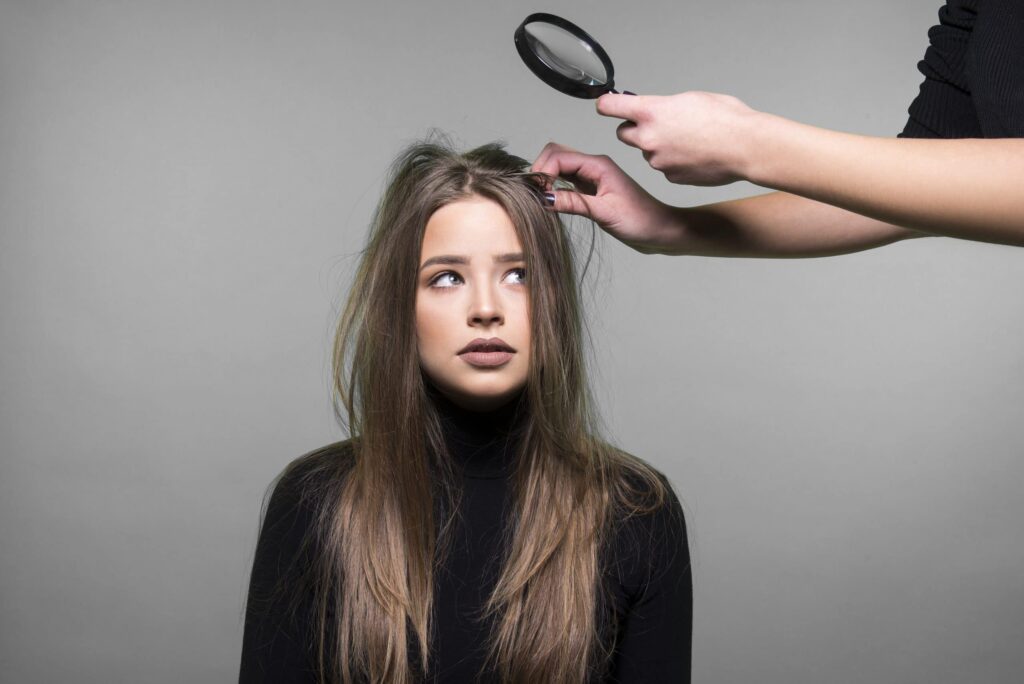
Can Hormonal Imbalance Cause Hair Loss?
- February 6, 2022
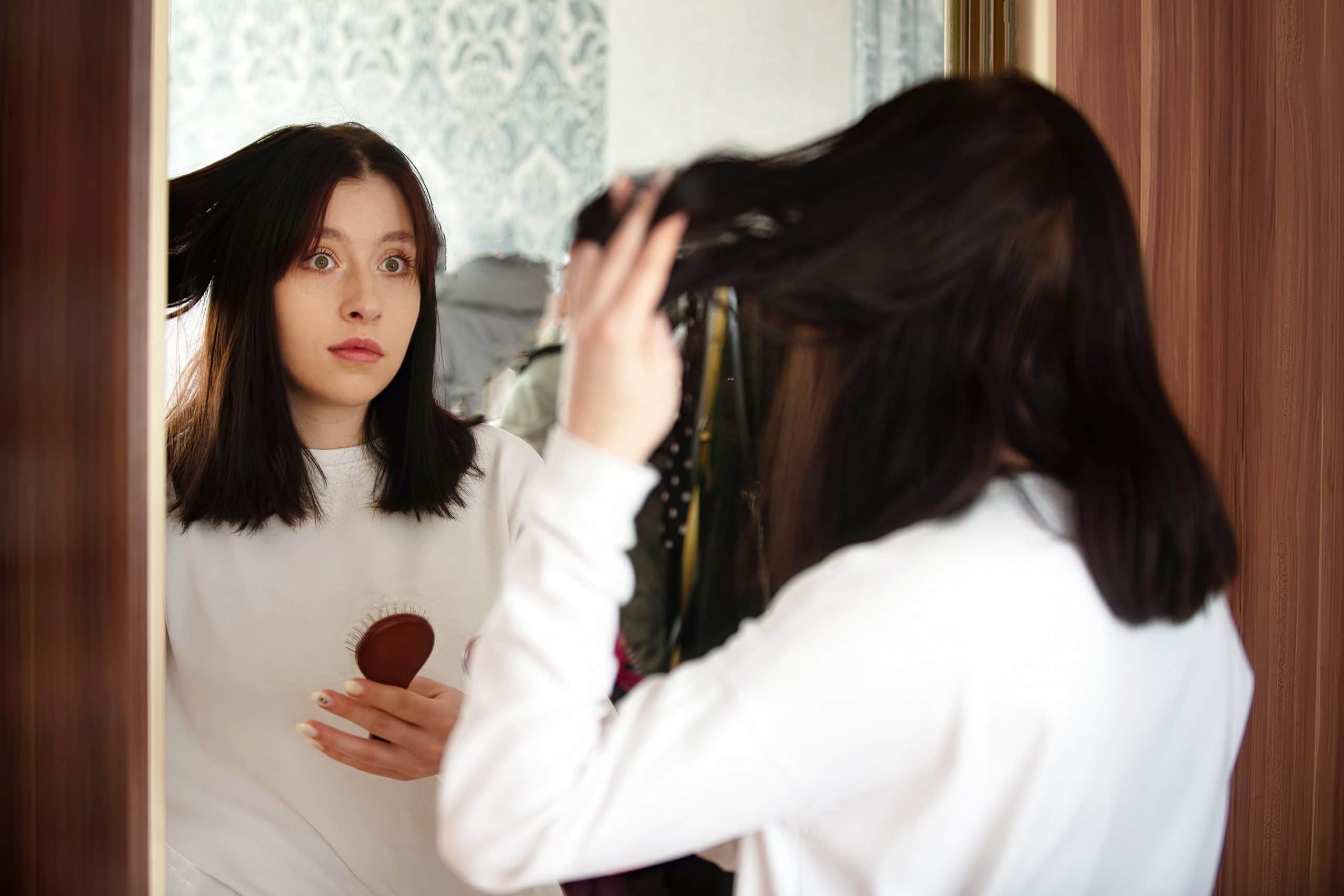

Have you heard the phrase, “Your hair is your crowning glory” before? Or maybe even seen some bottles of supplements on the shelves of pharmacies that are named “Crowning Glory”, aimed to provide vitamin and mineral solutions to target hormonal imbalances for hair growth and health? After all, there’s many things that women will do in the name of beauty – endure the pain of waxing and plucking, wear killer heels at the expense of their feet, and spend hours at salons… But there is little that can compare to what women – and men! – will do to protect the crown of their head. Hours at the salon? No problem. Monthly scalp and hair treatments? I’ll make time! A full head of hair can symbolise health, prosperity, and femininity in the case of females. It’s something that we can’t take off at the end of the day, like make-up, so we had better make sure it looks thick and healthy at all times.
Also Read: Guide To Hair Loss Treatments In Singapore
However, hair loss in men and women can be a frustrating struggle. It may creep up on us suddenly, months before we realise that the amount of hair we see in our shower drains or home floors may not be as normal as we thought. And since we don’t look at the back of our heads or top of our crown so often, we may not even realise that patches are appearing that start to expose the skin of our scalp until a loved one or a close friend points it out to us. Even then, hair loss can be a sensitive topic and it may even be a while until they have the courage to bring it up to us!
Hair loss in men and women may occur due to different reasons. Hair loss in men is often known as male pattern hair loss (MPHL), or the scientific name ‘androgenetic alopecia’. This is mostly due to genetic factors and hormonal imbalances that can cause problems with the hair follicles and subsequently hair loss. Female pattern hair loss (FPHL), or ‘female androgenetic alopecia’, is also a common term used to describe hair loss in females, but it may not be as attributed to hormones as it is in females. Let’s take a deep dive into understanding what hormonal imbalances are responsible for hair loss in males and females today, as we go through:
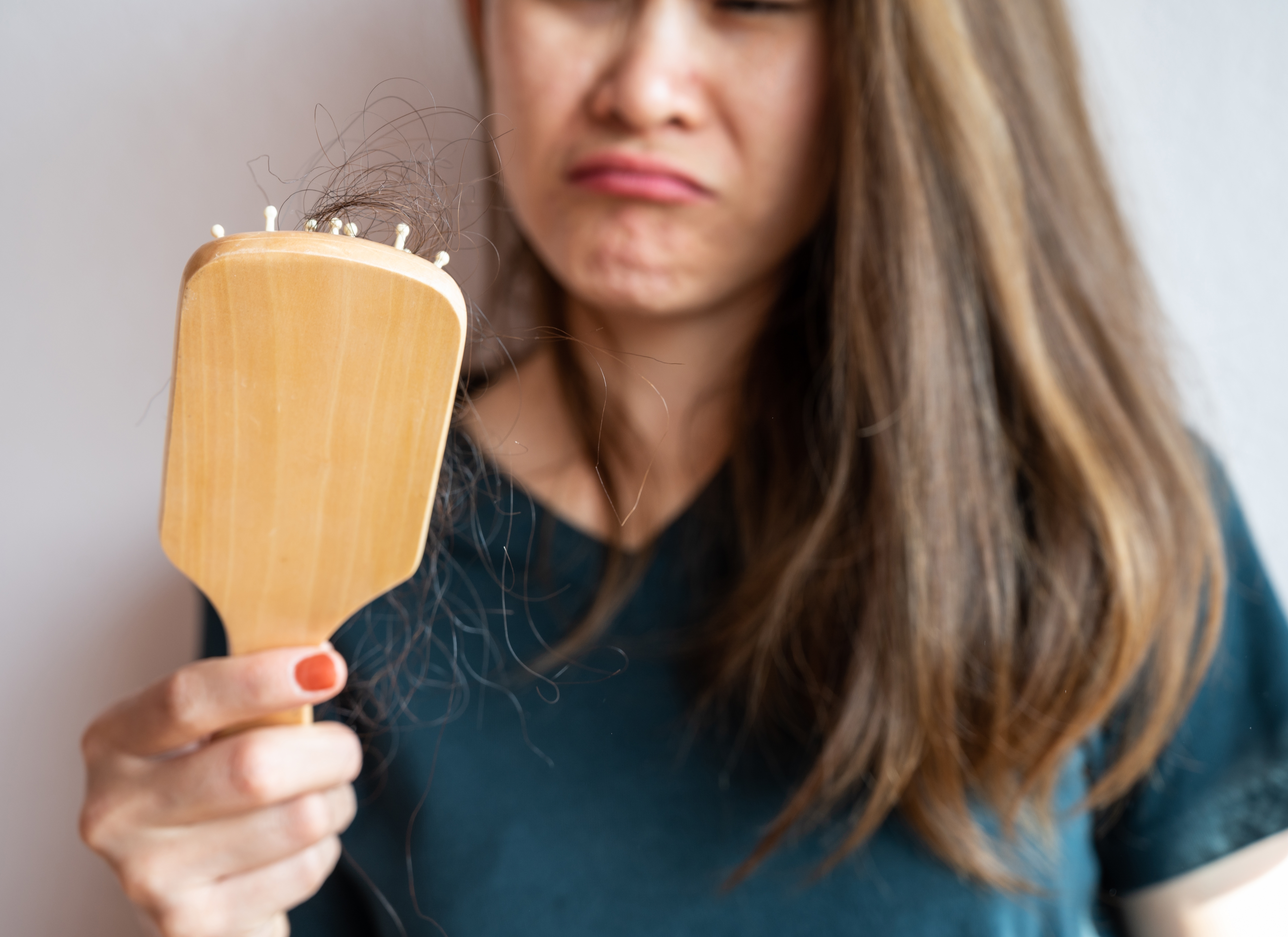 Which Hormones Are Responsible For Hair Loss?
Which Hormones Are Responsible For Hair Loss?Hormones responsible for hair loss tend to be slightly different in men and in women. However, genetics does play a big role in persistent hair loss conditions. The ‘genetics’ in male or female ‘androgenetic alopecia’ refers to an inherited hair loss trait either on both sides of the family tree, or just the maternal or paternal side. The field of genetics is a huge and complex topic, but the bottom line is that certain people may have inherited a higher percentage of ‘balding genes’ which are more easily activated.
Interesting facts: A 2017 review found 63 highly-possible genes that play a role in male pattern baldness, and only 6 of them found on the X-chromosome which comes from the mother – meaning that if your father had male pattern baldness, you have a higher chance of it too! Whereas for females, an estimate of 1 in 2 women will experience female pattern hair loss by the time they’re 80. Hence, although there is no clear indication that your hair loss will start or progress similarly to your family members, those with stronger genetic predisposition to hair loss may start balding earlier than those with a weaker predisposition, who may only start balding in their 60s or 70s.
Now comes the ‘hormonal’ part of hair loss, which is the ‘androgen’ part of ‘androgenetic alopecia’. Androgen is the hormonal part of balding and refers to hormones that normally circulate in the bloodstream. In men, this is due to male hormones, mainly testosterone, that circulate in the bloodstream and are broken down by enzymes in the hair follicles on the scalp. The most common sign of hair loss in men is usually first detected when there is noticeable thinning of hair in the middle of the scalp along with a receding hairline (loss of hair starting from the front till the back).
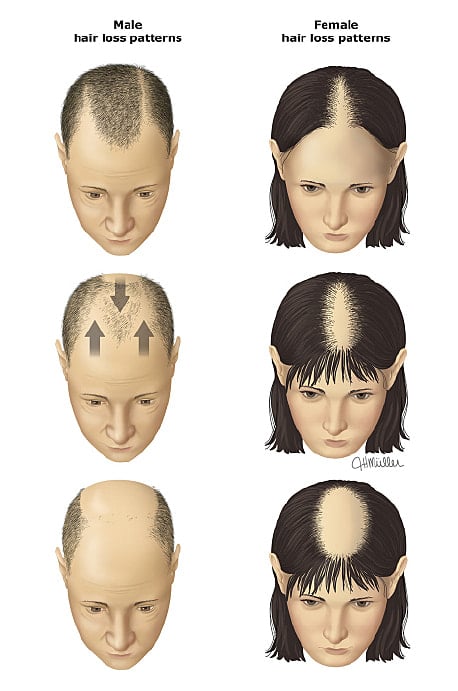
In females, the role of hormonal imbalance during hair loss is still not as clear as it is in males. In fact, female pattern hair loss can still occur in females that have normal levels of circulating androgens! That is why some dermatologists may prefer to use the term ‘female pattern hair loss’ instead of androgenetic alopecia to avoid suggesting a role for androgens in this type of hair loss. On the other hand, many women with excessive or reduced hormones also exhibit and complain of scalp hair loss, which indicates a role of androgens in female hair loss.
These sex hormones like low progesterone or estradiol, or estrogen deficiency can cause hair loss. Common signs of female pattern hair loss are slightly different than in males, who commonly lose hair starting from the front till the back. Female hair loss normally looks like a slowly progressive hair thinning, mainly over the top of the head. Unlike in males, the frontal hairline is often not affected or not as severe; however, hair thinning is more diffused and spread out.
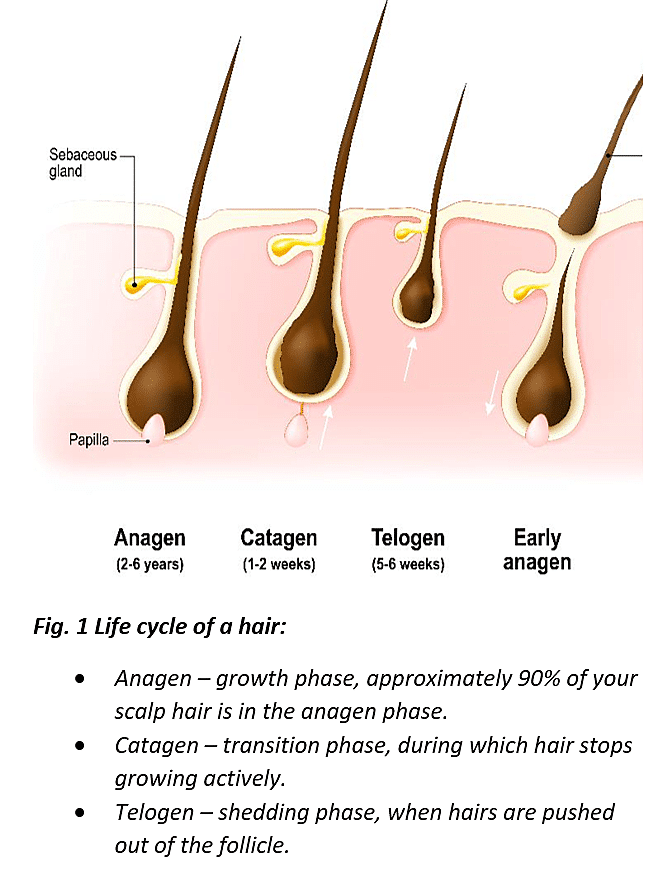
Before we jump into how hormonal imbalances affect hair loss, we need to understand the anatomy of the hair follicle. Hair loss happens because the anatomy of the hair follicle is affected, or because the hair cycle is affected. Hair follicles are actually always in action, constantly undergoing cyclical rounds of rest a.k.a. telogen phase (lasting 5-6 weeks), early anagen or anagen phase which is the growth phase (lasting 2-6 years), and degeneration phase called catagen (lasting 1-2 weeks). This is the unique quality of our hair follicles, the ability to dynamically move between active growth and rest.
When hormones, especially testosterone in males, are carried to the blood vessels around the hair follicles and are broken down, di-hydrotestosterone (DHT) is released. DHT does two things: 1) It shortens the anagen/growth phase of the hair cycle, and 2) It causes hair follicles to become smaller, called ‘miniaturisation’. Miniaturisation of the hair follicles simply means that the hair follicles shrink and become more shallow in depth. At the same time, a shortened anagen or growth cycle of the hair means that the hair does not have a chance to grow stronger in those already miniaturised hair follicles, and over time this causes the hair itself becoming shorter and finer until no new hairs grow – hence, balding. The most susceptible hair follicles tend to be located in the front of the scalp, causing the classic receding hairline found in male pattern baldness.
In females, sex hormones like estrogen, estradiol, or progesterone increases the amount of time that hair spends in the anagen/growing phase which is particularly nurturing to hair, expanding the growth phase, and preventing shedding. The effect of this is greatly seen during pregnancy, where the enhanced supply of estradiol and progesterone that helps to nurture the growing life causes the pregnant lady to have glowing skin and a thick head of hair that doesn’t shed easily. When the levels of these hormones decline such as during post-partum periods or during menopause, hair loses these protective effects. At the same time, the androgenic effects of testosterone can also be intensified – female bodies also contain testosterone, and similar to male pattern hair loss, this testosterone can metabolise DHT that produces progressively weaker hair and eventual hair loss through hair follicle miniaturisation and shorter hair growth cycles.
1. Hair Loss Medication
Medication aims to stop hormonal hair loss by increasing blood flow and anagen growth phase of the hair follicle, as well as inhibiting 5-alpha reductase enzymes to reduce conversion of testosterone to DHT. This is mainly through the use of topical minoxidil application to the scalp, or finasteride medication. It usually takes 6 to 12 months of use before an individual knows if it works for them. Once you stop taking prescription medication, you will start to lose the hair that grew and this happens in about three to four months.
Also Read: Are Hair Loss Treatments In Singapore Expensive?
2. Regenera Activa Hair Restoration
Regenera Activa is a method of hair stimulation that uses regenerative cells harvested from micro-grafts of your own healthy hair and injected into other scalp areas. This makes it so that the body’s own stem cells and growth factors trigger tissue regeneration in hair follicles, as hair loss on the scalp is often due to poor follicle health. Regenera can help the process of repairing the damaged or miniaturised hair follicle, which assists in physically reversing the signs of hair loss. It is considered to be less invasive when compared to other hair loss treatments such as hair transplantation, and results can be visible much sooner. Downtime is minimal and visible changes can be seen by 8 weeks of treatment, after one session, and results can continue to improve for up to 2 years. It is good for small areas of hair loss.
3. Hair Transplantation
Hair transplantation in Singapore is more invasive than the other two solutions, but provides a great solution for larger areas of hair loss. It is considered a surgery and is an invasive procedure that requires downtime of 1 week due to post-surgery recovery, and the shaving of hair is generally necessary. Follicular Unit Extraction (FUE) hair transplantation is a process where each individual follicular unit is harvested from the scalp. They are removed through microscopic circular incisions on the scalp in a random fashion from the donor area that has less noticeable thinning of the area, and are transplanted to the thinning area for healing and growth to occur over time naturally.
To a certain extent, YES, hormonal hair loss can be reversible, more so than genetic factors. However, many external and environmental factors play a role as well. As hormones can be highly affected by diet and lifestyle, we need to make sure that those factors are balanced as well while we are undergoing treatment.
Stress can put your body in constant fight or flight a.k.a. survival mode, which brings blood flow away from your skin and hair follicles and focuses it on your main organs (like your heart pumping excessively). When this happens, stress hormones like cortisol can also damage the hair follicles, even though they aren’t sex hormones. You don’t even have to wait till menopause hits for hair loss to accelerate – many women in their 20s and 30s with excessive stress start losing hair due to a stressful lifestyle.
Diet affects hair loss if you are not ingesting enough calories to meet your daily requirements, or if you are not getting enough essential nutrients like protein, fatty acids, and zinc that contribute to hair growth. Without these nutrients, your hair will have a higher chance of thinning out and dropping, called ‘telogen effluvium’ meaning excessive shedding of telogen hair (hair in the resting phase) after a shock to the system like poor dieting.
Hair loss from hormonal imbalances is something that may feel untreatable, but a large portion of it can be helped. Whether you are male or female, hair loss does not discriminate. Get in contact with one of our professional doctors today to learn more about how our hair loss treatment in Singapore can help you with your hair loss issues and discuss treatment plans that can be customised to your specific condition and budget!
Like what you read? Share them!